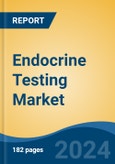Mass Spectroscopy is the fastest growing segment, Europe is the largest market globally
Speak directly to the analyst to clarify any post sales queries you may have.
10% Free customizationThis report comes with 10% free customization, enabling you to add data that meets your specific business needs.
Key Market Drivers
The rising prevalence of endocrine disorders fundamentally drives the demand for diagnostic solutions. Conditions such as thyroid dysfunction, diabetes, and adrenal insufficiencies are increasingly widespread globally, necessitating accurate and timely identification for effective management and improved patient outcomes. This escalating burden translates directly into a greater need for comprehensive endocrine testing.Key Market Challenges
The high cost associated with advanced testing technologies represents a significant impediment to the growth of the global endocrine testing market. This financial barrier directly restricts the widespread adoption of essential diagnostic procedures, particularly in developing regions where healthcare budgets are often limited. Smaller healthcare settings globally also face considerable challenges in acquiring and maintaining these expensive platforms, which consequently curtails their capacity to offer a comprehensive range of endocrine tests.Key Market Trends
The growth of direct-to-consumer endocrine testing offerings is a significant market trend, enabling individuals to directly access diagnostic services without a traditional physician's referral. This paradigm shift democratizes access to health information, empowers patients in their wellness journeys, and fosters a proactive approach to health management. According to the American Diabetes Association's 2024 Annual Report, nearly 1 in 2 Americans has diabetes or prediabetes, collectively representing 136 million Americans living with these conditions.Key Market Players Profiled:
- Abbott Laboratories
- Agilent Technologies Inc.
- Bio-Rad Laboratories Inc.
- AB Sciex
- bioMerieux SA
- DiaSorin S.p.A.
- F. Hoffmann-La Roche Ltd.
- Laboratory Corporation of America Holdings
- Quest Diagnostics Incorporated
- Ortho Clinical Diagnostics
Report Scope:
In this report, the Global Endocrine Testing Market has been segmented into the following categories:By Test Type:
- Estradiol (E2) Test
- Follicle Stimulating Hormone (FSH) Test
- Human Chorionic Gonadotropin (hCG) Hormone Test
- Luteinizing Hormone (LH) Test
- Dehydroepiandrosterone Sulfate (DHEAS) Test
- Progesterone Test
- Testosterone Test
- Thyroid Stimulating Hormone (TSH) Test
- Prolactin Test
- Cortisol Test
- Insulin Test
- Others
By Technology:
- Tandem Mass Spectrometry
- Immunoassay
- Monoclonal & Polyclonal Antibody Technologies
- Sensor Technology
- Clinical Chemistry
- Others
By End user:
- Hospitals & Clinics
- Ambulatory Care Centers
- Others
By Region:
- North America
- Europe
- Asia Pacific
- South America
- Middle East & Africa
Competitive Landscape
Company Profiles: Detailed analysis of the major companies present in the Global Endocrine Testing Market.Available Customizations:
With the given market data, the publisher offers customizations according to a company's specific needs. The following customization options are available for the report:- Detailed analysis and profiling of additional market players (up to five).
This product will be delivered within 1-3 business days.
Table of Contents
Companies Mentioned
- Abbott Laboratories
- Agilent Technologies Inc.
- Bio-Rad Laboratories Inc.
- AB Sciex
- bioMerieux SA
- DiaSorin S.p.A.
- F. Hoffmann-La Roche Ltd.
- Laboratory Corporation of America Holdings
- Quest Diagnostics Incorporated
- Ortho Clinical Diagnostics
Table Information
| Report Attribute | Details |
|---|---|
| No. of Pages | 185 |
| Published | November 2025 |
| Forecast Period | 2024 - 2030 |
| Estimated Market Value ( USD | $ 2.81 Billion |
| Forecasted Market Value ( USD | $ 4.69 Billion |
| Compound Annual Growth Rate | 8.9% |
| Regions Covered | Global |
| No. of Companies Mentioned | 10 |









